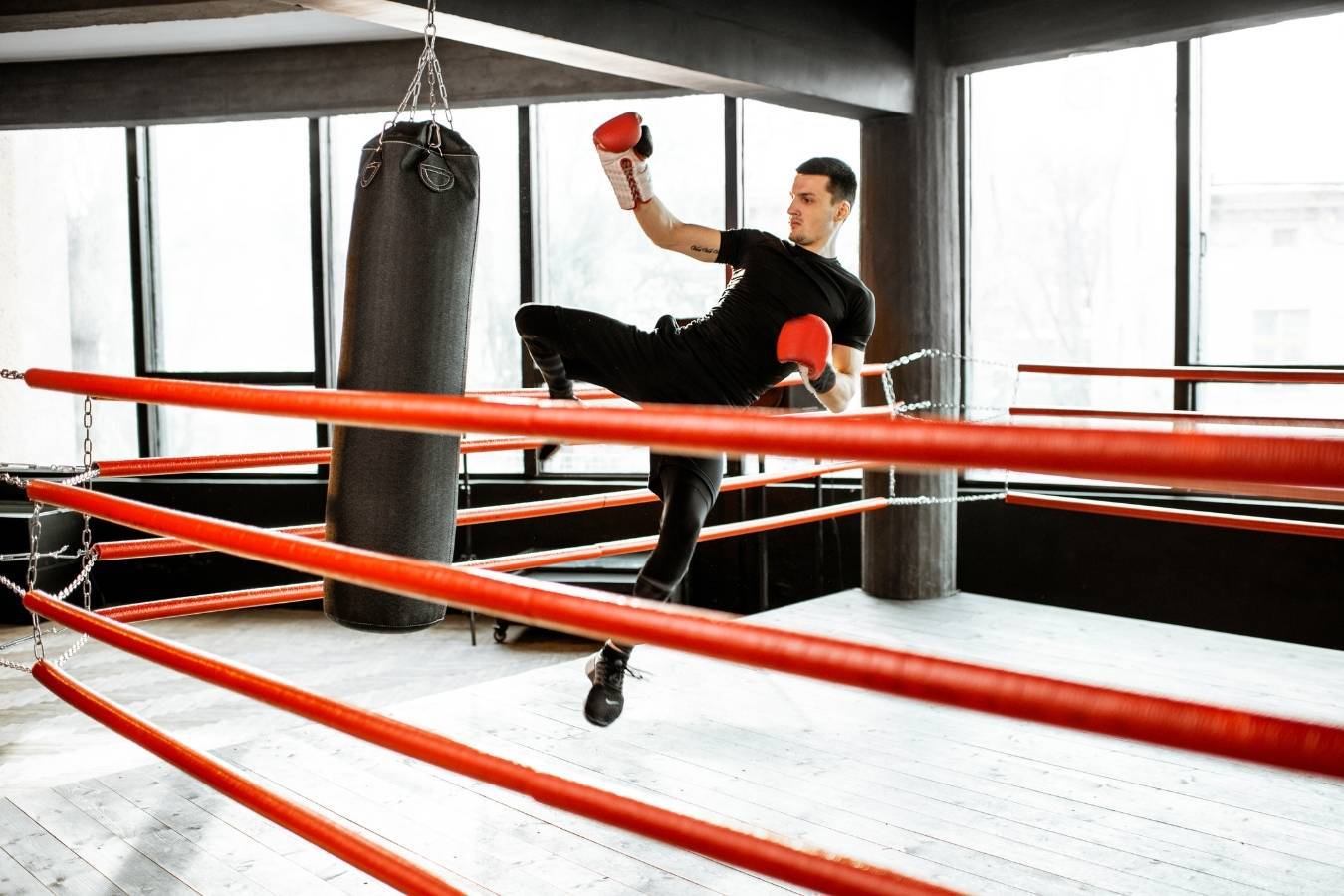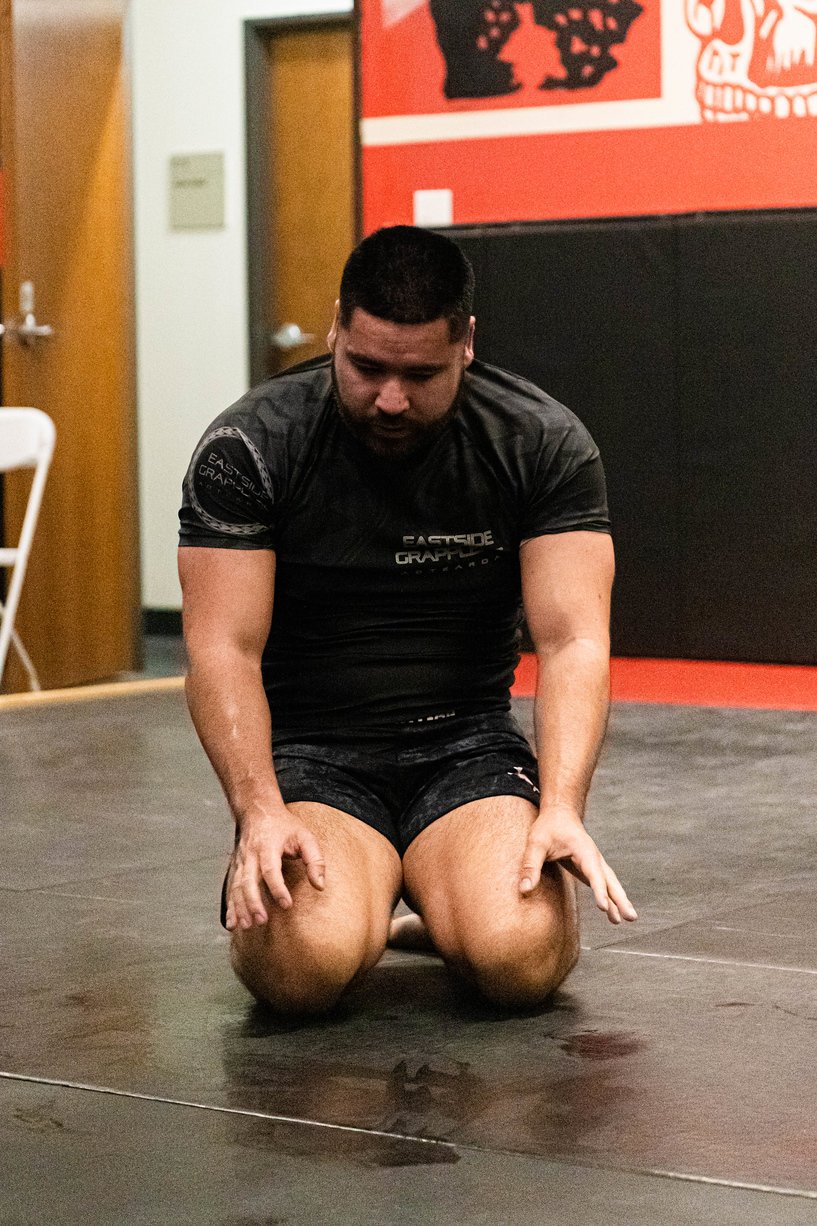The consequences of poor conditioning when kickboxing can be devastating. While skills pay the bills, you need to have a level of conditioning that will let you use those skills to protect yourself and land enough strikes to win the fight.
Conditioning for kickboxing requires well-developed aerobic and anaerobic capacity to sustain high-intensity offensive and defensive actions. Successful kickboxers can perform more offensive and defensive actions compared to losing fighters.
Understanding the profiles of elite kickboxers and the activity profiles of kickboxing bouts, we can determine the best course of action for kickboxing conditioning.
Physiological Profile Of A Kickboxer

4 elite level kickboxers from Canada (one was the current ISKA and PKA professional world welterweight champion) had an average VO2max of 62.7 ml.kg-1.min-1 which ranged from 54-69 ml.kg-1.min-1 between all four kickboxers [1].
This would be considered VERY high and similar to the aerobic capacities of elite-level boxers and wrestlers and approaching elite endurance athlete levels.

FREE Strength & Conditioning Program To Never Gas Out In The Ring
30-second anaerobic power in these kickboxers averaged 761 W for the lower body and 392 W for the upper body.
Similar values were found in 10 top Portuguese kickboxers showing an average VO2max of 62.5 ml.kg-1.min-1 and lower body anaerobic power of 608 W [2].
These power values are similar to high-level wrestlers.
Conversely, 20 kickboxers from the highest level of K-1 were put through a range of tests which were analyzed against technical and tactical actions during kickboxing matches [3]. They found these athletes had an average VO2max of 47.6 ml.kg-1.min-1 which is much lower than the previous two studies.
This was likely due to the testing procedures where the previous two studies used direct measurement during cycling and running while this study estimated VO2max during a step-up test which may have underestimated it.
What was interesting about this study was that kickboxers with higher VO2max levels had higher indicators of activeness, effectiveness, and efficiency of attacks during combat.
Activeness was defined as the number of registered offensive actions divided by the number of bouts fought.
Effectiveness was defined as the number of effective attacks divided by the number of all attacks. Essentially a percentage of strikes landed. The efficiency of attacks was defined as the number of attacks awarded 1 point divided by the number of bouts.
10 national Turkish national and international kickboxers had VO2max values of 48.5 ml.kg-1.min-1 which was also predicted [4].
These data suggest that both aerobic and anaerobic energy systems must be maximized for high-level kickboxing performance.
Physiological Demands Of Kickboxing

During simulated light contact combat (with slightly longer between round rest times) of Turkish national and international kickboxers, the average heart rate corresponded to 87% of maximum heart rate [4].
This would be considered zone 4 regarding heart rate zones and very, very close to zone 5 which would be the red zone. This percentage of heart rate maximum increased from approximately 84% in the first round to 90% in the third round indicating the increased cardiovascular demands as the fight progresses.
This was also seen in blood lactate concentrations increasing from approximately 6 mmol.L-1 to 12 mmol.L-1 suggesting large contributions from the anaerobic lactic energy system.
Another study in amateur kickboxers participating in simulated kickboxing competition found blood lactate values to increase from approximately 8 mmol.L-1 to 15 mmol.L-1 with heart rate increasing from 141 BPM to 182 BPM [9].
In 8 semi-professional Italian K-1 fighters, blood lactate concentrations reached approximately 15 mmol.L-1 after official competition showing similar increases in anaerobic processes between simulated and official bouts [10].
The researchers state that K-1 fighters need to improve their ability to tolerate lactate accumulation to perform a greater number of attacking and defensive actions.
Blood lactate levels >10 mmol.L-1 are considered highly anaerobic. Overall, we can see that kickboxing elicits high aerobic and anaerobic demands.
Activity Profile Of Kickboxing

In amateur kickboxing, the effort to pause ratio was found to be 1:2 consisting of 6 seconds activity with 12 seconds of preparation and observation [6]. In regional and national level kickboxers from Tunisia, a 1:4 to 1:5 effort to pause ratio was found in simulated combat [7].
When analyzing international kickboxing competitions of different styles (point fighting, light contact, and full contact), Tunisian kickboxers were found to have an effort to pause ratio of 1:4 for point fighting, 1:3 for light contact, and 1:2 for full contact [8].
This was broken down to approximately 2 seconds of high-intensity effort interspersed with the pause period. The greater effort to pause ratio for point fighting rulesets is likely due to the referee stoppages.
Based on these data, full-contact kickboxing requires greater aerobic demands than point-fighting rulesets. However, high levels of aerobic development are needed in all rulesets to optimize recovery between high-intensity efforts and rounds.
Winners vs. Losers: What Dictates Success In Kickboxing
This is always my favorite section in these conditioning breakdowns. Differentiating between winners and losers, or elite and non-elite, provides us with the most important information for success in kickboxing.
It seems regarding physical and physiological variables, no differences are seen between winners and losers meaning both fighters are exposed to similar outputs [4].
This increased activity by winners seems to reduce handgrip strength after a fight which may indicate higher neuromuscular fatigue which can’t be tolerated to the same extent in losers [13].
The most effective offensive techniques to win fights by knockout were found to be the hook and roundhouse kick to the head and this was the same between amateur and professional fighters [12].
Being able to throw more offensive and defensive techniques, and tolerate the build-up of lactate while doing so, seems to be the key to kickboxing success.
Kickboxing Conditioning

Developing insane energy system conditioning is one thing. But the most important scoring factor in kickboxing is the timing of offensive and defensive techniques [5]. Which is executing a technique at the right time to surprise an opponent and score. Also known as agility.
We also know that winners perform more offensive and defensive techniques so are more active during a fight. Common sense would dictate that skills training should be used as conditioning modalities as much as possible depending on kickboxing training volume.
Regarding energy system development, there is a push and pull between aerobic and anaerobic capacity. Meaning if we go too far in one direction, the other will suffer. Striking the right balance in energy system development is important for overall success.
However, balance does not mean splitting even time between anaerobic and aerobic targeted training. To tolerate lactate accumulation, throw more strikes than an opponent, and recover between efforts and rounds, aerobic capacity must be prioritized.
A-lactic training must also be trained alongside aerobic capacity to increase the power output of strikes.
Finally, anaerobic lactic-style training is the icing on the cake closer to a fight. Further, this energy system will be touched on during sparring and other technical style training.
Aerobic Capacity For Kickboxing
Cardiac Output
Low intensity, steady-state cardio is the foundation for overall aerobic conditioning. It is often seen as training to avoid as it is believed to make you slow.
This couldn’t be further from the truth when it is programmed correctly. If all you do is perform cardiac output for 90+ minute sessions multiple times a week and no other speed or power training, then yes, you are likely to get slower.
But when programmed alongside proper speed and power training, and a-lactic energy system development, it will build a massive gas tank.
Further, there are highly beneficial adaptations to the heart that higher intensity training can’t elicit. In fact, higher intensity training promotes the opposite adaptations.
This adaptation to low-intensity training is the dilation of one of the heart chambers where blood is pooled between heartbeats and then pumped to the working muscles. This dilation of the heart chamber allows more blood to be pooled between each heartbeat resulting in more blood being delivered to the working muscles.
More blood means more oxygen being delivered which means more energy that can be produced aerobically prolonging the time to fatigue.
Performing this type of training is very simple. First, you will need a heart rate monitor. The Polar H10 is my go-to recommendation for the most accurate monitor that is easy to use.
Simply perform 30-90 minutes of low-intensity, continuous exercise at a heart rate between 110-150 BPM. I've expanded the heart rate range below the typical recommendation of 130-150 BPM as that can sometimes be considered higher intensity depending on your individual response to exercise.
As an example, I feel best and find a carry-over to sport performing cardiac output at around 120 BPM.
Exercise ideally would be continually using kickboxing techniques. For example, shadowboxing or bag work.
Here is a typical 4-week progression you could use.
Week | Exercise | Time |
|---|---|---|
Week 1 | Shadowboxing/Bag Work | 30 minutes |
Week 2 | Shadowboxing/Bag Work | 40 minutes |
Week 3 | Shadowboxing/Bag Work | 50 minutes |
Week 4 | Shadowboxing/Bag Work | 60 minutes |
Cardiac Power
This is a higher intensity conditioning modality that borders as anaerobic lactic power. However, the goal of this conditioning modality is to improve the contractile ability of the heart. Meaning it can sustain high heart rates for longer and provide more forceful contractions.
All geared towards increasing the amount of blood that can be pumped per heartbeat. To perform cardiac output training, simply keep your heart rate as high as possible for 60-120 seconds. Rest 2-5 minutes between sets or when your heart rate drops between 120-130 BPM.
The other benefit to this type of training is you can train your heart rate recovery ability between efforts. Try different breathing techniques to bring your heart rate down faster each time.
Here is an example 4-week progression.
Week | Exercise | Set/Rep | Rest |
|---|---|---|---|
Week 1 | Kickboxing Drills | 4 x 60 sec | 2-5 min or HR between 120-130 BPM |
Week 2 | OR | 6 x 60 sec | 2-5 min or HR between 120-130 BPM |
Week 3 | Off-Feet Cardio | 8 x 60 sec | 2-5 min or HR between 120-130 BPM |
Week 4 | Cell | 4 x 90 sec | 2-5 min or HR between 120-130 BPM |
Threshold Training
Another method to increase the power of the aerobic energy system. The idea is to shift the threshold in which predominantly aerobic processes switch to predominantly anaerobic processes to higher heart rates known as the anaerobic threshold.
Why is this important? The longer we can stay predominantly aerobic when training or competing, the longer we can fight before fatigue.
The other benefit to this style of conditioning is being able to perform rounds similar to fight conditions. For example, 3x2min rounds with 1min between rounds.
Using your heart rate monitor, keep your heart rate ± 5 BPM of your anaerobic threshold. This can be determined by your average heart rate during a 5–6-minute conditioning test.
As a general estimation, 165-175 BPM is a range you can work off if you are not testing.
Here is a 4-week example which
Week | Exercise | Set/Rep | Rest |
|---|---|---|---|
Week 1 | Kickboxing Drills | 4 x 90 sec | 90 sec |
Week 2 | OR | 2 x 2 min | 2 mins |
Week 3 | Off-Feet Cardio | 3 x 2 min | 90 sec |
Week 4 | Cell | 3 x 2 min | 1 min |
Anaerobic Power & Capacity For Kickboxing
Anaerobic lactic training is the icing on the cake after developing a huge aerobic gas tank.
Lactic Capacity Intervals
The ability to tolerate high lactate build-up is a key performance indicator for kickboxing. While a well-developed aerobic energy system will help buffer this lactate to use for energy production, at some point, the aerobic energy system won’t be able to keep up.
In these circumstances, you must possess the ability to repeat very high-intensity efforts. Each of these intervals should be near maximal to maintain this intensity for every working set.
Again, you should be performing these intervals using kickboxing techniques as much as possible as it’s kickboxing that makes you tired. So, performing lactic capacity intervals while swimming won’t give you the same transfer.
Here is an example 4-week progression.
Week | Exercise | Set/Rep | Rest |
|---|---|---|---|
Week 1 | Kickboxing Drills | 2x (2 x 60 sec/90 sec) | 6-8 min active recovery |
Week 2 | OR | 2x (3 x 60 sec/90 sec) | 6-8 min active recovery |
Week 3 | Off-Feet Cardio | 3x (2 x 60 sec/90 sec) | 6-8 min active recovery |
Week 4 | Cell | 3x (3 x 60 sec/90 sec) | 6-8 min active recovery |
Lactic Power Intervals
These intervals are to help develop power combinations and should be performed using kickboxing techniques. The heavy bag is perfect for these types of intervals.
Here is an example 4 week progression.
Week | Exercise | Set/Rep | Rest |
|---|---|---|---|
Week 1 | Kickboxing Drills | 2x (3 x 20 sec/120 sec) | 8-15 min active recovery (shadowboxing) |
Week 2 | OR | 3x (3 x 20 sec/120 sec) | 8-15 min active recovery (shadowboxing) |
Week 3 | Off-Feet Cardio | 3x (2 x 20 sec/90 sec) | 8-15 min active recovery (shadowboxing) |
Week 4 | Cell | 3x (3 x 20 sec/90 sec) | 8-15 min active recovery (shadowboxing) |
A-Lactic Power & Capacity
While no research to date has investigated direct energy system contribution to kickboxing, we can assume high a-lactic contributions due to the speed and power of various striking combinations.
A-Lactic Power
While the gym and sport itself will take care of a-lactic power, performing a-lactic power intervals can help transfer the speed and power developed in the gym to kickboxing.
These intervals can be performed for as many sets to technical failure or a pre-determined number of sets.
Here is a 4-week example.
Week | Exercise | Set/Rep | Rest |
|---|---|---|---|
Week 1 | Heavy Bag | 5 x 6 sec | 3 min |
Week 2 | OR | 6 x 6 sec | 3 min |
Week 3 | Off-Feet Cardio | 6 sec x technical failure | 3 min |
Week 4 | Cell | 6 sec x technical failure | 3 min |
A-Lactic Capacity
This is the ability to repeat these maximal, short burst efforts. We can train this by extending the interval lengths to the edge of the a-lactic energy system and repeat with incomplete rest.
Here is a 4-week example.
Week | Exercise | Set/Rep | Rest |
|---|---|---|---|
Week 1 | Heavy Bag | 10 x 10 sec/20 sec | Cell |
Week 2 | OR | 2x (8 x 10 sec/20 sec) | 8-10 min active recovery (light shadowboxing) |
Week 3 | Off-Feet Cardio | 2x (10 x 10 sec/20 sec) | 8-10 min active recovery (light shadowboxing) |
Week 4 | Cell | 3x (8 x 10 sec/20 sec) | 8-10 min active recovery (light shadowboxing) |
References
1. Zabukovec, R., & Tiidus, P. M. (1995). Physiological and anthropometric profile of elite kickboxers. The Journal of Strength & Conditioning Research, 9(4), 240-242.
2. Silva, P., Silva, M., Duarte, J., Ahmed, A., Tavares, O., Valente-Dos-Santos, J., ... & Coelho-E-Silva, M. J. (2016). Physical, physiological characteristics and sport goal orientation of top Portuguese kickboxing athletes. Revista de Artes Marciales Asiáticas, 11(2s), 34-35.
3. Rydzik, Ł., & Ambroży, T. (2021). Physical fitness and the level of technical and tactical training of kickboxers. International Journal of Environmental Research and Public Health, 18(6), 3088.
4. Salci, Y. (2015). The metabolic demands and ability to sustain work outputs during kickboxing competitions. International Journal of Performance Analysis in Sport, 15(1), 39-52.
5. Slimani, M., Chaabene, H., Miarka, B., Franchini, E., Chamari, K., & Cheour, F. (2017). Kickboxing review: anthropometric, psychophysiological and activity profiles and injury epidemiology. Biology of sport, 34(2), 185.
6. Silva, J. J. R., Del Vecchio, F. B., Picanço, L. M., Takito, M. Y., & Franchini, E. (2011). Time-motion analysis in Muay-Thai and kick-boxing amateur matches. Journal of Human Sport and Exercise, 6(3), 490-496.
7. Ouergui, I., Davis, P., Houcine, N., Marzouki, H., Zaouali, M., Franchini, E., ... & Bouhlel, E. (2016). Hormonal, physiological, and physical performance during simulated kickboxing combat: Differences between winners and losers. International journal of sports physiology and performance, 11(4), 425-431.
8. Ouergui, I., Benyoussef, A., Houcine, N., Abedelmalek, S., Franchini, E., Gmada, N., ... & Bouassida, A. (2019). Physiological Responses and Time-Motion Analysis of Kickboxing: Differences Between Full Contact, Light Contact, and Point Fighting Contests. Journal of strength and conditioning research.
9. du Système Nerveux, C. H. U. (2013). Anaerobic upper and lower body power measurements and perception of fatigue during a kick boxing match. The Journal of sports medicine and physical fitness, 53, 455-60.
10. Cimadoro, G. (2017). Acute neuromuscular, cognitive and physiological responses to a Japanese kickboxing competition in semi-professional fighters. The journal of sports medicine and physical fitness, 58(12), 1720-1727.
11. Ouergui, I., Hssin, N., Franchini, E., Gmada, N., & Bouhlel, E. (2013). Technical and tactical analysis of high level kickboxing matches. International Journal of Performance Analysis in Sport, 13(2), 294-309.
12. Ambroży, T., Rydzik, Ł., & Kędra, A. (2020). The effectiveness of kickboxing techniques and its relation to fights won by knockout.
13. Tassiopoulos, I., & Nikolaidis, P. T. (2013). Acute effect of official kickboxing game on handgrip muscle strength: winners vs. losers. Journal of Physical Education and Sport, 13(2), 266.


